2015 HYUNDAI TUCSON engine coolant
[x] Cancel search: engine coolantPage 571 of 653
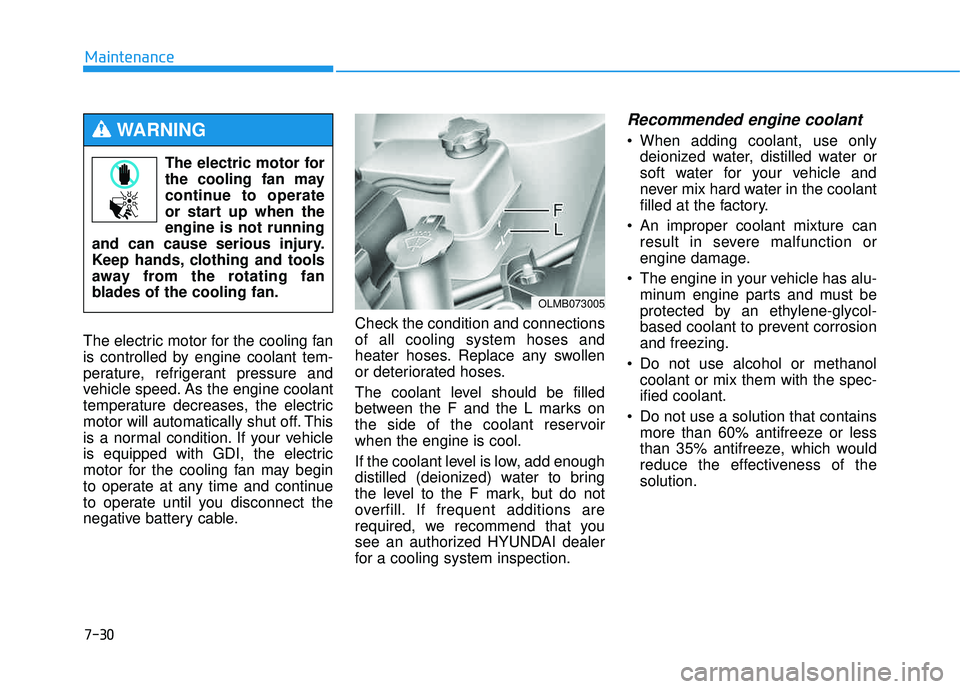
7-30
Maintenance
The electric motor for the cooling fan
is controlled by engine coolant tem-
perature, refrigerant pressure and
vehicle speed. As the engine coolant
temperature decreases, the electric
motor will automatically shut off. This
is a normal condition. If your vehicle
is equipped with GDI, the electric
motor for the cooling fan may begin
to operate at any time and continue
to operate until you disconnect the
negative battery cable.Check the condition and connectionsof all cooling system hoses and
heater hoses. Replace any swollen
or deteriorated hoses.
The coolant level should be filled
between the F and the L marks on
the side of the coolant reservoirwhen the engine is cool.
If the coolant level is low, add enough
distilled (deionized) water to bring
the level to the F mark, but do not
overfill. If frequent additions are
required, we recommend that you
see an authorized HYUNDAI dealer
for a cooling system inspection.
Recommended engine coolant
When adding coolant, use only
deionized water, distilled water or
soft water for your vehicle and
never mix hard water in the coolant
filled at the factory.
An improper coolant mixture can result in severe malfunction or
engine damage.
The engine in your vehicle has alu- minum engine parts and must be
protected by an ethylene-glycol-
based coolant to prevent corrosionand freezing.
Do not use alcohol or methanol coolant or mix them with the spec-ified coolant.
Do not use a solution that contains more than 60% antifreeze or less
than 35% antifreeze, which would
reduce the effectiveness of thesolution.
OLMB073005
The electric motor for
the cooling fan may
continue to operate
or start up when theengine is not running
and can cause serious injury.
Keep hands, clothing and tools
away from the rotating fan
blades of the cooling fan.
WARNING
Page 572 of 653
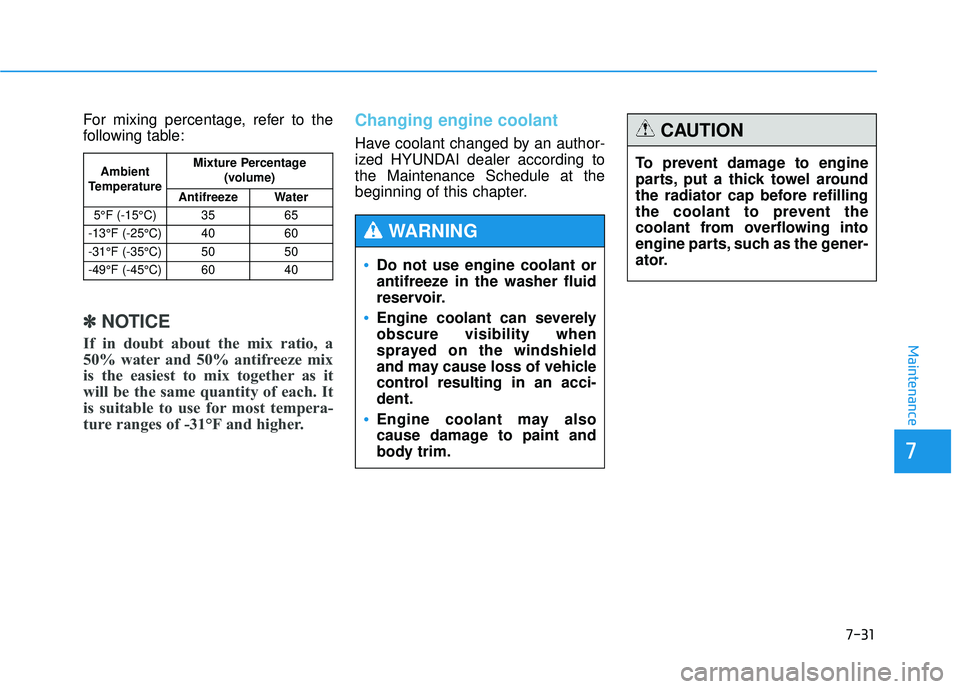
7-31
7
Maintenance
For mixing percentage, refer to the
following table:
✽✽NOTICE
If in doubt about the mix ratio, a
50% water and 50% antifreeze mix
is the easiest to mix together as it
will be the same quantity of each. It
is suitable to use for most tempera-
ture ranges of -31°F and higher.
Changing engine coolant
Have coolant changed by an author-
ized HYUNDAI dealer according tothe Maintenance Schedule at the
beginning of this chapter.
Ambient
Temperature Mixture Percentage
(volume)
Antifreeze Water
5°F (-15°C) 35 65
-13°F (-25°C) 40 60
-31°F (-35°C) 50 50
-49°F (-45°C) 60 40
Do not use engine coolant or
antifreeze in the washer fluid
reservoir.
Engine coolant can severely obscure visibility when
sprayed on the windshield
and may cause loss of vehicle
control resulting in an acci-dent.
Engine coolant may also
cause damage to paint and
body trim.
WARNING
To prevent damage to engine
parts, put a thick towel around
the radiator cap before refilling
the coolant to prevent the
coolant from overflowing into
engine parts, such as the gener-
ator.
CAUTION
Page 575 of 653
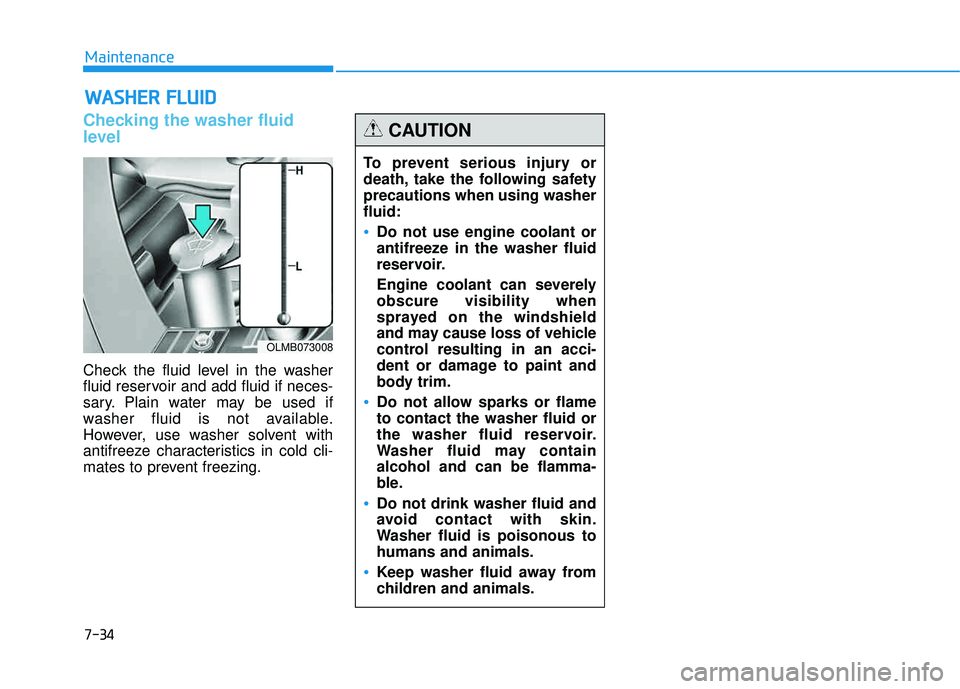
7-34
Maintenance
WWAASSHH EERR FF LLUU IIDD
Checking the washer fluid
level
Check the fluid level in the washer
fluid reservoir and add fluid if neces-
sary. Plain water may be used if
washer fluid is not available.
However, use washer solvent with
antifreeze characteristics in cold cli-
mates to prevent freezing.
OLMB073008
To prevent serious injury or
death, take the following safetyprecautions when using washerfluid:
Do not use engine coolant or
antifreeze in the washer fluid
reservoir.
Engine coolant can severely obscure visibility when
sprayed on the windshield
and may cause loss of vehicle
control resulting in an acci-
dent or damage to paint and
body trim.
Do not allow sparks or flame to contact the washer fluid or
the washer fluid reservoir.
Washer fluid may containalcohol and can be flamma-
ble.
Do not drink washer fluid and
avoid contact with skin.
Washer fluid is poisonous tohumans and animals.
Keep washer fluid away from
children and animals.
CAUTION
Page 632 of 653
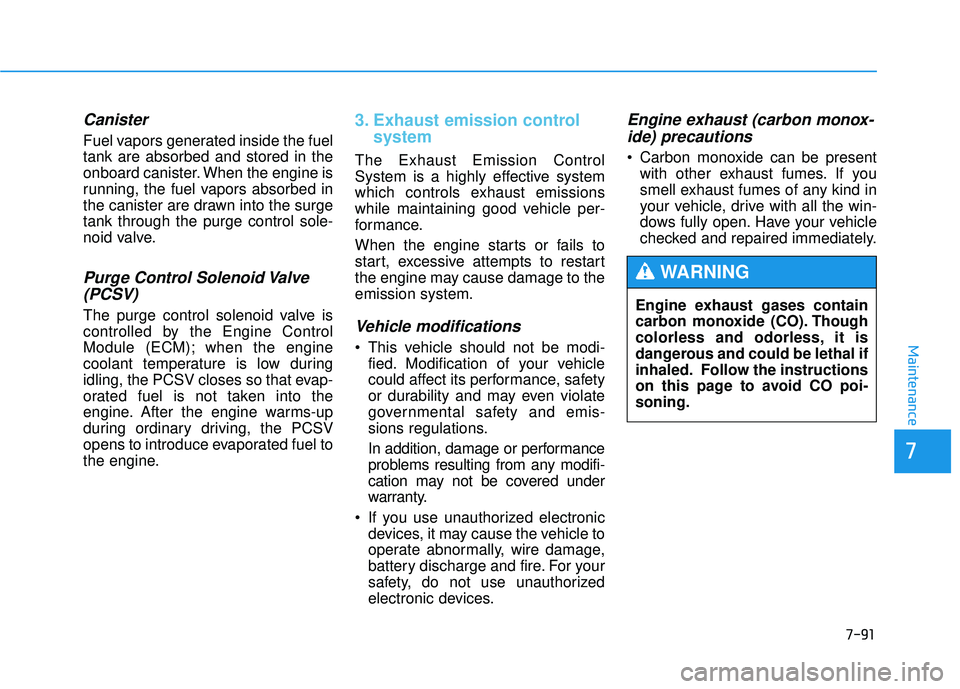
7-91
7
Maintenance
Canister
Fuel vapors generated inside the fuel tank are absorbed and stored in the
onboard canister. When the engine is
running, the fuel vapors absorbed in
the canister are drawn into the surgetank through the purge control sole-
noid valve.
Purge Control Solenoid Valve(PCSV)
The purge control solenoid valve is
controlled by the Engine Control
Module (ECM); when the engine
coolant temperature is low during
idling, the PCSV closes so that evap-
orated fuel is not taken into the
engine. After the engine warms-up
during ordinary driving, the PCSV
opens to introduce evaporated fuel to
the engine.
3. Exhaust emission control system
The Exhaust Emission Control
System is a highly effective system
which controls exhaust emissions
while maintaining good vehicle per-
formance.
When the engine starts or fails to
start, excessive attempts to restart
the engine may cause damage to theemission system.
Vehicle modifications
This vehicle should not be modi-fied. Modification of your vehicle
could affect its performance, safety
or durability and may even violate
governmental safety and emis-
sions regulations.
In addition, damage or performance
problems resulting from any modifi-
cation may not be covered under
warranty.
If you use unauthorized electronic devices, it may cause the vehicle to
operate abnormally, wire damage,
battery discharge and fire. For your
safety, do not use unauthorized
electronic devices.
Engine exhaust (carbon monox-
ide) precautions
Carbon monoxide can be present with other exhaust fumes. If you
smell exhaust fumes of any kind in
your vehicle, drive with all the win-
dows fully open. Have your vehicle
checked and repaired immediately.
Engine exhaust gases contain
carbon monoxide (CO). Though
colorless and odorless, it is
dangerous and could be lethal if
inhaled. Follow the instructions
on this page to avoid CO poi-soning.
WARNING
Page 639 of 653
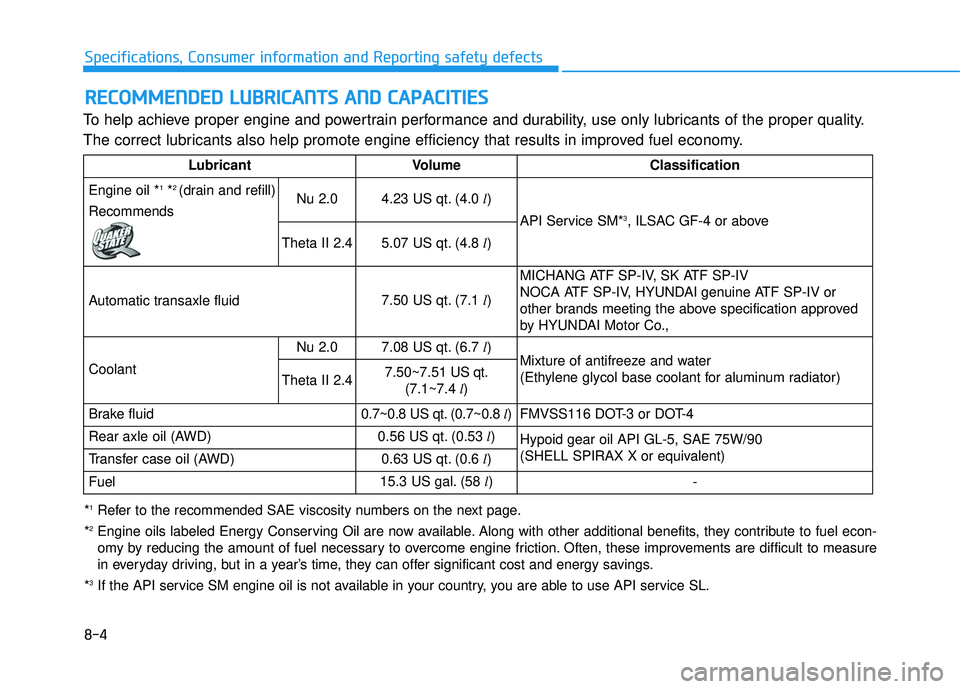
To help achieve proper engine and powertrain performance and durability, use only lubricants of the proper quality.
The correct lubricants also help promote engine efficiency that results in improved fuel economy.
RREECCOO MM MMEENN DDEEDD LL UU BBRRIICC AA NN TTSS AA NN DD CC AA PPAA CCIITT IIEE SS
8-4
Specifications, Consumer information and Reporting safety defects
*1
Refer to the recommended SAE viscosity numbers on the next page.
* 2
Engine oils labeled Energy Conserving Oil are now available. Along with other additional benefits, they contribute to fuel econ-
omy by reducing the amount of fuel necessary to overcome engine friction. Often, these improvements are difficult to measure
in everyday driving, but in a year’s time, they can offer significant cost and energy savings.
* 3
If the API service SM engine oil is not available in your country, you are able to use API service SL.
LubricantVolumeClassification
Engine oil * 1
*2
(drain and refill)
RecommendsNu 2.04.23 US qt. (4.0 l)
API Service SM* 3
, ILSAC GF-4 or above
Theta II 2.45.07 US qt. (4.8 l)
Automatic transaxle fluid7.50 US qt. (7.1 l)
MICHANG ATF SP-IV, SK ATF SP-IV
NOCA ATF SP-IV, HYUNDAI genuine ATF SP-IV or
other brands meeting the above specification approved
by HYUNDAI Motor Co.,
Coolant
Nu 2.07.08 US qt. (6.7 l)Mixture of antifreeze and water
(Ethylene glycol base coolant for aluminum radiator)
Theta II 2.47.50~7.51 US qt.
(7.1~7.4 l)
Brake fluid0.7~0.8 US qt. (0.7~0.8 l)FMVSS116 DOT-3 or DOT-4
Rear axle oil (AWD)0.56 US qt. (0.53 l)Hypoid gear oil API GL-5, SAE 75W/90
(SHELL SPIRAX X or equivalent)
Transfer case oil (AWD)0.63 US qt. (0.6 l)
Fuel15.3 US gal. (58 l)-
Page 647 of 653

I-3
Anti-lock brake system (ABS) ...................................5-31
Electronic stability control (ESC) ..............................5-34
Vehicle stability management (VSM) ........................5-37
Hill-start assist control (HAC) ...................................5-39
Downhill brake control (DBC) ..................................5-40
Bulb replacement ............................................................7-74
Bulb wattage .....................................................................8-2
Button start/stop, see engine start/stop button ..................5-8
California perchlorate notice ..........................................7-94
Care
Tire care ......................................................................7-47
Exterior care ...............................................................7-83
Interior care ................................................................7-88
Cargo security screen ....................................................3-123
CD player ........................................................................4-16
Center console storage ..................................................3-116
Central door lock switch .................................................3-16
Chains Tire chains ..................................................................5-56
Changing a Tire with TPMS ...........................................6-13
Changing tires .................................................................6-16
Check tire inflation pressure ...........................................7-49
Checking the engine oil lever .........................................7-27
Child restraint system (CRS) ..........................................2-36 Selecting a Child Restraint System (CRS).................2-37
Installing a Child Restraint System (CRS) ................2-39 Child-protector rear door lock ........................................3-18
Cigarette lighter ............................................................3-118
Climate control air filter ...............................................3-101
Climate control air filter .................................................7-38
Combined instrument, see instrument cluster ................3-20
Compact spare tire replacement .....................................7-52
Compass with Electric chromic mirror...........................3-46
Consumer information ......................................................8-8
Coolant ............................................................................7-29
Cooling fluid, see engine coolant ...................................7-29
Crankcase emission control system ................................7-90
Cruise control system .....................................................5-45
Cup holder .....................................................................3-119
Dashboard illumination, see instrument panel illumination.3-21
Dashboard, see instrument cluster ..................................3-20
Day/night rearview mirror ..............................................3-44
Daytime running light .....................................................3-80
Defogging (Windshield)................................................3-112
Defroster (Rear window) ................................................3-91
Front windshield defroster .........................................3-92
Defrosting (Windshield)................................................3-112
Digital clcok..................................................................3-121
Dimensions .......................................................................8-2
Display illumination, see instrument panel illumination ....3-21
Displays, see instrument cluster .....................................3-20
I
Index
C
D
Page 648 of 653
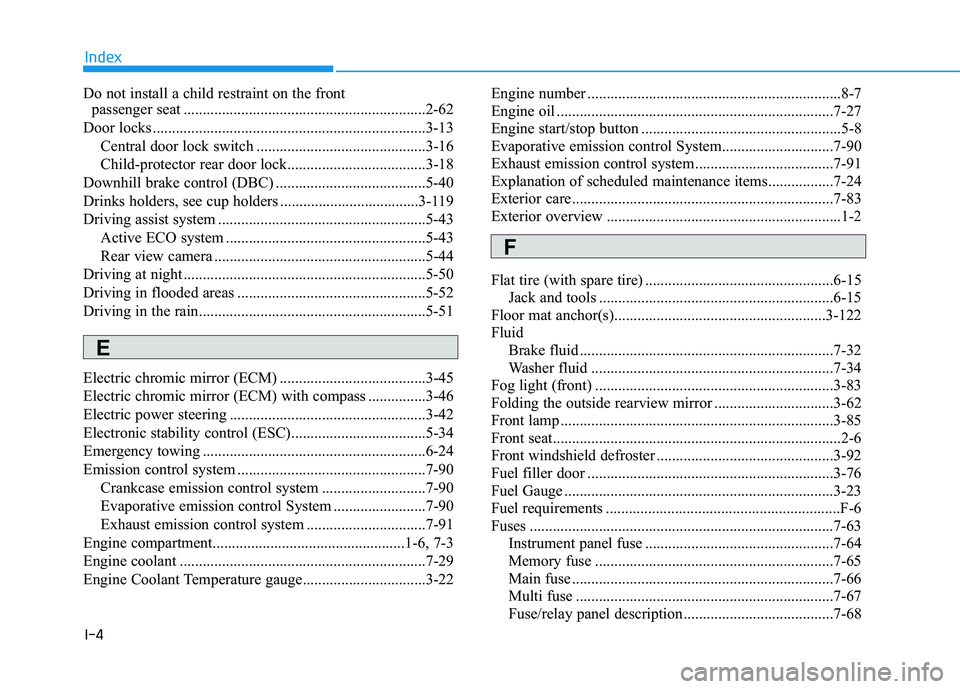
I-4
Do not install a child restraint on the frontpassenger seat ...............................................................2-62
Door locks .......................................................................3-13 Central door lock switch ............................................3-16
Child-protector rear door lock....................................3-18
Downhill brake control (DBC) .......................................5-40
Drinks holders, see cup holders ....................................3-119
Driving assist system ......................................................5-43 Active ECO system ....................................................5-43
Rear view camera .......................................................5-44
Driving at night ...............................................................5-50
Driving in flooded areas .................................................5-52
Driving in the rain...........................................................5-51
Electric chromic mirror (ECM) ......................................3-45
Electric chromic mirror (ECM) with compass ...............3-46
Electric power steering ...................................................3-42
Electronic stability control (ESC)...................................5-34
Emergency towing ..........................................................6-24
Emission control system .................................................7-90 Crankcase emission control system ...........................7-90
Evaporative emission control System ........................7-90
Exhaust emission control system ...............................7-91
Engine compartment..................................................1-6, 7-3
Engine coolant ................................................................7-29
Engine Coolant Temperature gauge................................3-22 Engine number ..................................................................8-7
Engine oil ........................................................................7-27
Engine start/stop button ....................................................5-8
Evaporative emission control System.............................7-90
Exhaust emission control system....................................7-91
Explanation of scheduled maintenance items.................7-24
Exterior care....................................................................7-83
Exterior overview .............................................................1-2
Flat tire (with spare tire) .................................................6-15
Jack and tools .............................................................6-15
Floor mat anchor(s).......................................................3-122
Fluid
Brake fluid ..................................................................7-32
Washer fluid ...............................................................7-34
Fog light (front) ..............................................................3-83
Folding the outside rearview mirror ...............................3-62
Front lamp .......................................................................3-85
Front seat...........................................................................2-6
Front windshield defroster ..............................................3-92
Fuel filler door ................................................................3-76
Fuel Gauge ......................................................................3-23
Fuel requirements .............................................................F-6
Fuses ...............................................................................7-63 Instrument panel fuse .................................................7-64
Memory fuse ..............................................................7-65
Main fuse ....................................................................7-66
Multi fuse ...................................................................7-67
Fuse/relay panel description .......................................7-68
Index
E
F